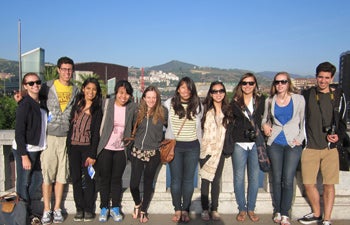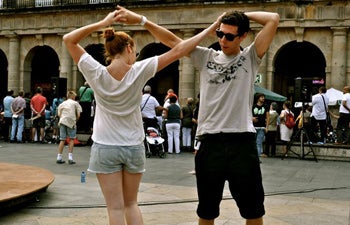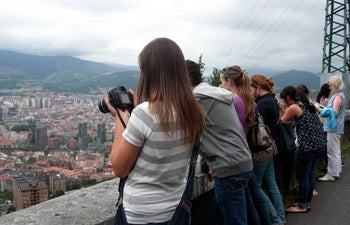A Romance Language Perfected
Inside a Taper Hall classroom, USC Dornsife senior Bridget McDonald chatted with classmates, effortlessly transitioning from English to Spanish.
The Pasadena, Calif., native’s confidence faltered, however, when native Spanish speakers struck up a conversation with her.
That was before she spent a month in Spain.
“I can’t emphasize how dramatically better my Spanish speaking skills became,” said McDonald, who is majoring in environmental studies with a minor in Spanish. “Being immersed in a culture requires you to muster the confidence to speak the language and forces you to speak it all the time.”
McDonald was among 10 USC students who traveled to Valencia, Spain, as part of USC Dornsife’s inaugural Valencia Summer Program. Leaving June 24, students relied on their Spanish speaking skills the second their airplane touched down in the country’s third largest city.
“It is always intimidating to speak to people who are fluent, but if you have no choice you do it,” said Kelsey Wang, a USC Dornsife senior majoring in biology with a double minor in art history and Spanish. “Now I don’t feel uncomfortable attempting to say things even if they’re not entirely grammatically correct.”

Marianna Chodorowska-Pilch, assistant professor of Spanish in USC Dornsife helped 10 USC students explore Spain during their four-week trip. Photo courtesy of Marianna Chodorowska-Pilch.
Complete immersion in a new culture is one aim of the program designed by Marianna Chodorowska-Pilch, assistant professor of Spanish in USC Dornsife. The program is a four-week interdisciplinary course that gives students a chance to improve their Spanish proficiency while providing a deeper understanding of immigration in Spain. Offered by the Department of Spanish and Portuguese and the School of International Relations in partnership with faculty from the University of Valencia, students probe different aspects of immigration through lectures and trips. The course gives them four credits.
“I always believed a course in Valencia would be an eye-opening experience for USC students because I am familiar with immigration in Spain,” Chodorowska-Pilch said. “Students learn how immigrants are perceived in Europe and how the same problem in the U.S. is being dealt with in Spain.”
Although Valencia has a population of more than 800,000, the city has a community feel, an ideal setting for students to mingle with residents. The low tourist numbers mean fewer opportunities to speak English.
The program will be held again Summer 2012. In addition to students studying Spanish and international relations, those interested in sociology and psychology or other fields may opt to take the course, Chodorowska-Pilch said. The course is open to all USC undergraduate and graduate students who have intermediate Spanish skills.
Linda Cole, associate director of the School of International Relations, said the Valencia course allows students to put into practice the research and analytic training they receive in their USC international relations coursework, as early as in their first international relations course, “Introduction to Foreign Policy Analysis.”
“They can apply writing and expository skills,” Cole said, “and collaborate with fellow students toward solving or unsnarling difficult local issues, such as immigration in Spain: how the government of Spain is dealing with the challenges of immigration as well as how immigrants are faring in Spain.
“Students will be able to relate this in-depth study undertaken in Valencia when they return to campus and continue to study similar challenges faced by peoples and governments all over the world.”

USC Dornsife students Bridget McDonald and Myles Lock dance to live music in a square in Bilbao. Photo courtesy of Kelsey Wang.
Applications for the June 16 to July 14, 2012, trip will be accepted starting on January 16, 2012.
In Valencia last summer, the course focusing on immigration was taught by Jesús García Verdugo from the Universidad Complutense de Madrid, and Edelia Villarroya Soler, professor and director of El Máster Internacional en Migraciones at the University of Valencia. Their lecturers covered topics from economic and historical aspects of immigration in Spain to the positive and negative consequences of the rising numbers of immigrants. Students also participated in “Escuela de verano” during which migration experts from Spain, Italy, Argentina and Mexico provided various viewpoints on the controversial issue.
Outside the seminar room, USC students spoke directly to immigrants.
At the Islamic Center of Valencia, students learned what life in Spain was like for Muslim women.
“The way we see Muslim women, as people wearing burkas and praying separately from the men, it seems like they are not equal,” said sophomore Asia Krupa, who is majoring in neuroscience in USC Dornsife. “However, when we asked one woman whether she felt equal as a woman in the Muslim culture, that seemed to surprise her, like how could we possibly think that she wouldn’t be.”
The city of Valencia became the students’ textbook. Chodorowska-Pilch led USC students on excursions to centers servicing immigrants run by immigrants. They spent time at the Hispano-Ecuatorian Association of Rumiñahui, a non-profit organization that helps facilitate immigrant integration, and Cáritas Diocesana de Valencia, a group of charities run by the Catholic Church of Spain. In the past decade, Spain has seen a large-scale wave of immigrants from North Africa, South America and Eastern Europe. Immigrants make up more than 12 percent of the country’s people with Romanians, Moroccans and Ecuadorians the largest of the foreign-born population.

USC undergraduate students look out over the city of Bilbao during USC Dornsife’s Valencia Summer Program in June 2011. Photo courtesy of Kelsey Wang.
The country experienced an economic surge during the 1990s when non-natives relocated to Spain to take jobs Spaniards didn’t find appealing in the construction and service sectors. Since 2008, a major recession in Spain has resulted in high jobless rates with immigrants hit the hardest.
“Studying immigration in Spain really allowed me to appreciate different aspects of immigration and understand how Spain fosters and welcomes immigrants into their country,” McDonald said.
In Spain, McDonald learned immigrants are regarded as contributing members of society. Established job initiatives and organizations help them prosper in the country.
Students discovered the beauty of Spain in trips led by Chodorowska-Pilch. They embraced the country’s culture and rush-free way of life, strolled along cobblestone streets and enjoyed the traditional, leisurely meals that span three to four hours. Among other things, they tasted paella and drank granizado at local restaurants, marveled at exhibits in Frank Gehry’s Guggenheim Museum Bilbao, and enjoyed a day at Albufera, a natural saltwater lagoon and estuary on the Gulf of Valencia.
“Marianna was amazing,” Wang said. “She knows the city and went out of her way to expose us to everything that would help us get the most out of the trip.”
One memorable weekend was spent soaking in the culture of northern Spain with trips to San Sebastian and Bilbao. They dined as northerners do — standing up and snacking on pintxos, the Basque word for tapas.
Back from Spain, McDonald said the program did more than fulfill her desire to travel abroad.
“It allowed me to gain confidence in my Spanish speaking skills,” said McDonald, who wants to eventually practice environmental law in Latin America. “I plan on traveling a lot and I now have a newfound appreciation for other societies and cultures. I now have the confidence to delve into a new culture and know I can acclimate.”
More information can be found at dornsife.usc.edu/spanish/study_abroad.